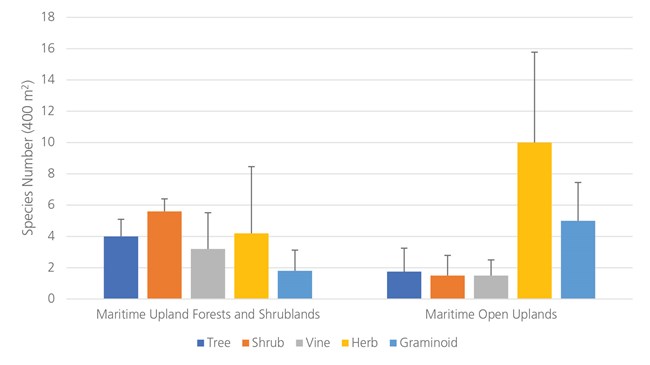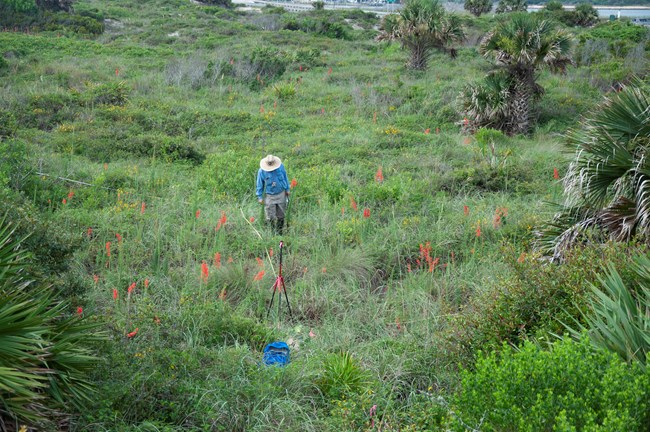Last updated: May 21, 2024
Article
Terrestrial Vegetation Monitoring 2019 Data Summary for Fort Matanzas National Monument

Overview
Vegetation communities are dynamic entities influenced by environmental factors and impacts from natural and anthropogenic disturbances. The diversity of plants within the southeastern Coastal Plain contributes to a range of ecological services, provides habitat and resources to an array of wildlife, and functions as nature’s backdrop—usually the primary visual cue pulling us toward an appreciation of the outdoors. Determining trends in vegetation communities over time and identifying plant stressors is therefore vital to understanding the ecological health of terrestrial ecosystems within Southeast Coast Network (SECN) parks. Collectively, this information can be used to guide management actions that sustain a park’s ecological integrity and support plant conservation across a diversity of spatial scales for generations to come.
Methods
The Southeast Coast Network collects long-term data on terrestrial vegetation within its parks using a peer-reviewed protocol similar to other NPS Inventory & Monitoring networks in the eastern U.S. and is modeled after the approach used to describe natural vegetation in the Southeast developed by the Carolina Vegetation Survey. Bounded and monumented plots are used to determine a site’s (1) vascular plant richness and abundance for all native and non-native species; (2) woody stem basal area, density and health for all native and non-native species; (3) density of forest floor fuels; (4) community level disturbance events, including presence of insect pests and disease; and (5) abiotic condition (e.g., landform shape, soil nutrients, canopy coverage and height). Plots are randomly located across broadly defined habitat types within SECN parks. Our sampling effort focuses on dominant (> 30% coverage) habitat types within these parks, but when time and resources allow, the sampling effort is increased to include less dominant types. The 2019 Terrestrial Vegetation Monitoring Protocol provides detailed descriptions of field and data processing techniques used by the Southeast Coast Network.
Study Area
Fort Matanzas National Monument (FOMA) covers approximately 121 hectares (298 acres) and is located along the Atlantic Ocean 14 miles south of St. Augustine in St. Johns County, Florida. The park is split between two parcels separated by the Matanzas River—the eastern parcel occurs on the southern tip of Anastasia Island while the western parcel is located on the northern third of Rattlesnake Island. The park is composed of open beaches adjacent to the ocean; foredunes of terraces adjacent to the beach; and further inland, stabilized dunes and backdunes supporting herbaceous-dominated sand flats, maritime scrub and forest. This protocol was implemented for the first time in the park in 2019, and these data represent the baseline status of vegetation and associated abiotic elements from the following broadly defined habitats of the park: Upland Forests/Shrublands and Open Upland Grasslands. Nine plots were established across these habitats (see map).
Significant Findings
Site and Environmental Factors
In the southeastern Coastal Plain, vegetation diversity is influenced by complex edaphic factors and their relationship with site hydrology and disturbance patterns (e.g., fire, storms). At Fort Matanzas National Monument, these wide-ranging environmental conditions were observed in the landform, soil, and disturbance data collected from vegetation plots. Soil pH values ranged from 5.3 (acidic) to 8.1 (slightly alkaline) and complex topography was evident within ridges and swales of both young and old dune systems. Fort Matanzas National Monument ecosystems have always been subjected to high frequencies of wind-, tide-, and wave-driven processes that sculpt vegetation composition and structure. Natural and human-caused disturbances affecting plants within other SECN parks—such as high herbivory rates, historical plowing, fire effects, and altered hydrology—were not observed within these plots during this survey effort.

Vegetation
Eighty-two plant species were observed across all plots, including eight taxa not detected in previous plant surveys. No rare species tracked by the state of Florida were detected during this survey effort. However, the newly described Florida blue curls (Trichostema species 2) was located within one of the Maritime Open Upland plots. This perennial blue curls has been historically aggregated in other floras with either common blue curls (T. dichotomum) or scrub blue curls (T. suffrutescens), but recent molecular phylogeny work suggests a taxonomic split. Conservation status of this plant is currently unknown. Overall, plot level plant richness ranged from 10 to 32 species, with graminoid and herbaceous plants providing the highest diversity within Maritime Open Upland habitat.

Nonnative species were encountered in three of the nine plots, including one occurrence of the invasive Brazilian pepper (Schinus terebinthifolia). Forested and shrubland habitats within the park were composed of a tree canopy dominated by cabbage palmetto (Sabal palmetto) and southern/eastern red cedar (Juniperus silicicola + virginiana); the sapling strata was dominated by yaupon (Ilex vomitoria).

NPS photo / Elizabeth Rico
Other Findings
- There were no living red bay trees observed within the park during this monitoring effort, although this species was identified as a principal understory tree during the park’s previous floristic survey in 2004. This could be a result of laurel wilt disease, which was detected in St. Johns County in 2006.
- Three species identified as commercially exploited by the Florida Department of Agriculture and Consumer Services were observed within monitoring plots. These include cinnamon fern (Osmundastrum cinnamomeum), saw palmetto (Serenoa repens), and coontie (Zamia integrifolia var. umbrosa)
- All plots are scheduled to be resampled in summer 2023.
Full Report
The full report for Terrestrial Vegetation Monitoring at Fort Matanzas National Monument 2019 Data Summary
About the Southeast Coast Network
In 1999, the National Park Service initiated a long-term ecological monitoring program, known as “Vital Signs Monitoring,” to provide the minimum infrastructure to allow more than 270 national park system units to identify and implement long-term monitoring of their highest-priority measurements of resource condition. The overarching purpose of natural resource monitoring in parks is to develop scientifically sound information on the current status and long-term trends in the composition, structure, and function of park ecosystems, and to determine how well current management practices are sustaining those ecosystems.
The NPS Vital Signs Monitoring Program addresses five goals for all parks with significant natural resources:
• Determine the status and trends in selected indicators of the condition of park ecosystem,
• Provide early warning of abnormal conditions,
• Provide data to better understand the dynamic nature and condition of park ecosystems,
• Provide data to meet certain legal and Congressional mandates, and
• Provide a means of measuring progress towards performance goals.
The Southeast Coast Network (SECN) includes eighteen administrative areas containing twenty park units, fifteen of which contain significant and diverse natural resources. In total, SECN parks encompass more than 184,000 acres of federally-managed land across North Carolina, South Carolina, Georgia, Alabama, and Florida. The parks serve a wide diversity of cultural and natural resource missions and include: five national monuments, four national seashores, three national battlefield parks, two national historic parks, a national memorial, a national recreation area, an ecological and historic preserve, and a single national park. The parks range in size from slightly more than 20 acres to nearly 60,000 acres, and when considered with non-federal lands jointly managed with NPS, the network encompasses more than 253,000 acres.
For More Information
SECN Home Page
https://www.nps.gov/im/secn/index.htm
SECN Reports & Publications
https://www.nps.gov/im/secn/reports-publications.htm
About the NPS Inventory & Monitoring Program
https://www.nps.gov/im/index.htm
Data Downloads via the Natural Resource Information Portal
https://irma.nps.gov/Portal/
